Answered step by step
Verified Expert Solution
Question
1 Approved Answer
For this assignment, use the small batch of data provided below. Enter the data into an SPSS worksheet-one column for each variable (group membership,
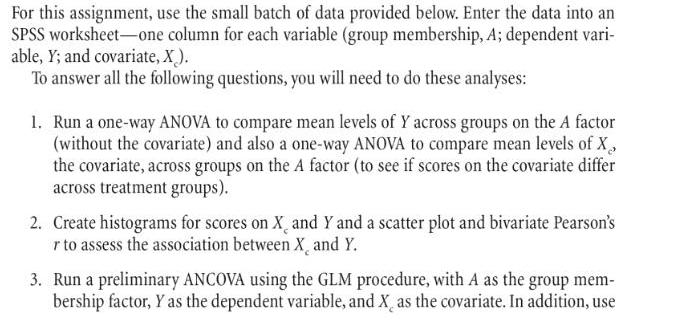
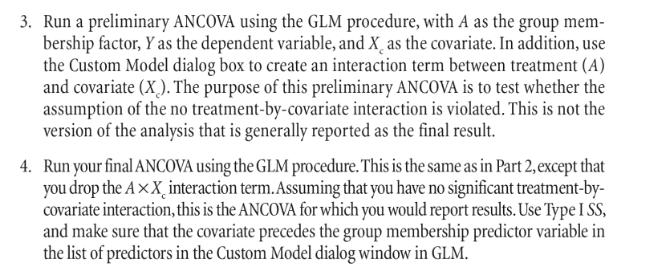
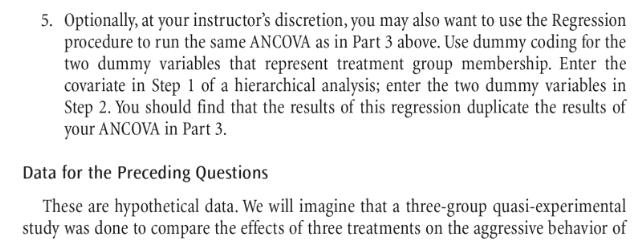
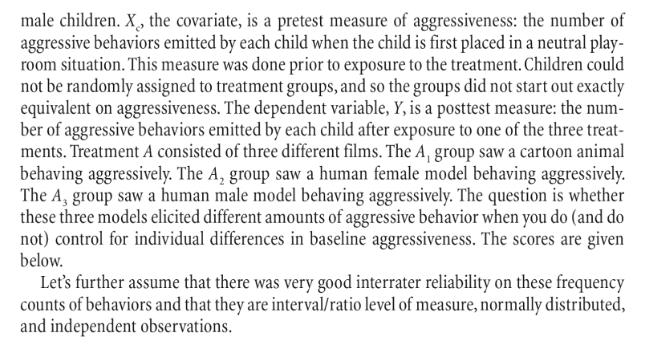
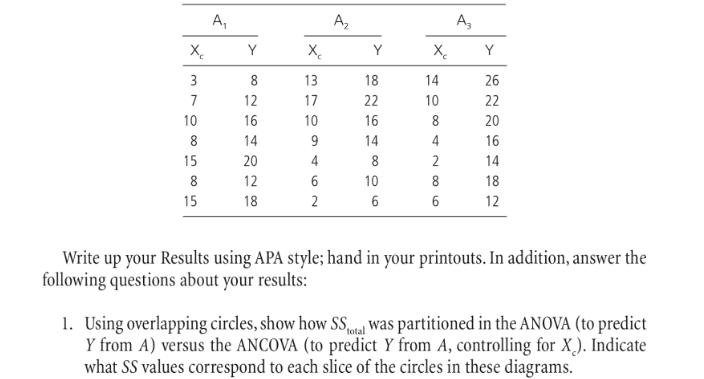
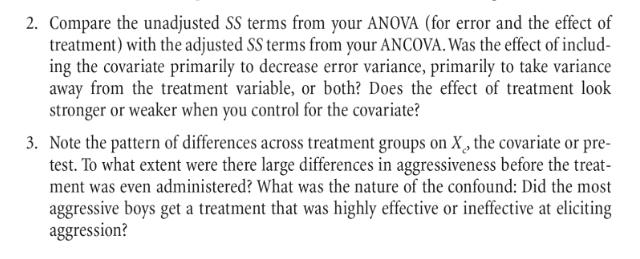
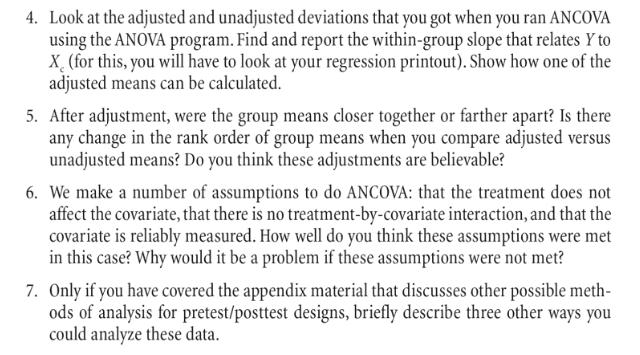
For this assignment, use the small batch of data provided below. Enter the data into an SPSS worksheet-one column for each variable (group membership, A; dependent vari- able, Y; and covariate, X). To answer all the following questions, you will need to do these analyses: 1. Run a one-way ANOVA to compare mean levels of Y across groups on the A factor (without the covariate) and also a one-way ANOVA to compare mean levels of X, the covariate, across groups on the A factor (to see if scores on the covariate differ across treatment groups). 2. Create histograms for scores on X and Y and a scatter plot and bivariate Pearson's r to assess the association between X and Y. 3. Run a preliminary ANCOVA using the GLM procedure, with A as the group mem- bership factor, Y as the dependent variable, and X, as the covariate. In addition, use 3. Run a preliminary ANCOVA using the GLM procedure, with A as the group mem- bership factor, Y as the dependent variable, and X as the covariate. In addition, use the Custom Model dialog box to create an interaction term between treatment (A) and covariate (X). The purpose of this preliminary ANCOVA is to test whether the assumption of the no treatment-by-covariate interaction is violated. This is not the version of the analysis that is generally reported as the final result. 4. Run your final ANCOVA using the GLM procedure. This is the same as in Part 2, except that you drop the AXX interaction term. Assuming that you have no significant treatment-by- covariate interaction, this is the ANCOVA for which you would report results. Use Type I SS, and make sure that the covariate precedes the group membership predictor variable in the list of predictors in the Custom Model dialog window in GLM. 5. Optionally, at your instructor's discretion, you may also want to use the Regression procedure to run the same ANCOVA as in Part 3 above. Use dummy coding for the two dummy variables that represent treatment group membership. Enter the covariate in Step 1 of a hierarchical analysis; enter the two dummy variables in Step 2. You should find that the results of this regression duplicate the results of your ANCOVA in Part 3. Data for the Preceding Questions These are hypothetical data. We will imagine that a three-group quasi-experimental study was done to compare the effects of three treatments on the aggressive behavior of male children. X, the covariate, is a pretest measure of aggressiveness: the number of aggressive behaviors emitted by each child when the child is first placed in a neutral play- room situation. This measure was done prior to exposure to the treatment. Children could not be randomly assigned to treatment groups, and so the groups did not start out exactly equivalent on aggressiveness. The dependent variable, Y, is a posttest measure: the num- ber of aggressive behaviors emitted by each child after exposure to one of the three treat- ments. Treatment A consisted of three different films. The A, group saw a cartoon animal behaving aggressively. The A, group saw a human female model behaving aggressively. The A, group saw a human male model behaving aggressively. The question is whether these three models elicited different amounts of aggressive behavior when you do (and do not) control for individual differences in baseline aggressiveness. The scores are given below. Let's further assume that there was very good interrater reliability on these frequency counts of behaviors and that they are interval/ratio level of measure, normally distributed, and independent observations. x 3 7 10 8 15 8 15 A Y 8 12 16 14 20 12 18 X 13 17 10 9 4 6 2 A Y 18 22 16 14 8 10 6 X 14 10 084 2 8 6 A Y 26 22 20 16 14 18 12 Write up your Results using APA style; hand in your printouts. In addition, answer the following questions about your results: 1. Using overlapping circles, show how SSotal was partitioned in the ANOVA (to predict Y from A) versus the ANCOVA (to predict Y from A, controlling for X). Indicate what SS values correspond to each slice of the circles in these diagrams. 2. Compare the unadjusted SS terms from your ANOVA (for error and the effect of treatment) with the adjusted SS terms from your ANCOVA. Was the effect of includ- ing the covariate primarily to decrease error variance, primarily to take variance away from the treatment variable, or both? Does the effect of treatment look stronger or weaker when you control for the covariate? 3. Note the pattern of differences across treatment groups on X, the covariate or pre- test. To what extent were there large differences in aggressiveness before the treat- ment was even administered? What was the nature of the confound: Did the most aggressive boys get a treatment that was highly effective or ineffective at eliciting aggression? 4. Look at the adjusted and unadjusted deviations that you got when you ran ANCOVA using the ANOVA program. Find and report the within-group slope that relates Y to X (for this, you will have to look at your regression printout). Show how one of the adjusted means can be calculated. 5. After adjustment, were the group means closer together or farther apart? Is there any change in the rank order of group means when you compare adjusted versus unadjusted means? Do you think these adjustments are believable? 6. We make a number of assumptions to do ANCOVA: that the treatment does not affect the covariate, that there is no treatment-by-covariate interaction, and that the covariate is reliably measured. How well do you think these assumptions were met in this case? Why would it be a problem if these assumptions were not met? 7. Only if you have covered the appendix material that discusses other possible meth- ods of analysis for pretest/posttest designs, briefly describe three other ways you could analyze these data.
Step by Step Solution
★★★★★
3.54 Rating (175 Votes )
There are 3 Steps involved in it
Step: 1
Results Descriptive Statistics Before conducting the analyses lets first examine the descriptive statistics for variables Y dependent variable and X covariate across the three treatment groups A A A G...
Get Instant Access to Expert-Tailored Solutions
See step-by-step solutions with expert insights and AI powered tools for academic success
Step: 2

Step: 3

Ace Your Homework with AI
Get the answers you need in no time with our AI-driven, step-by-step assistance
Get Started


